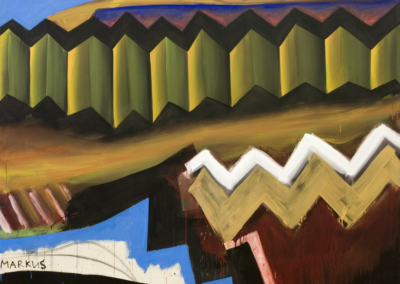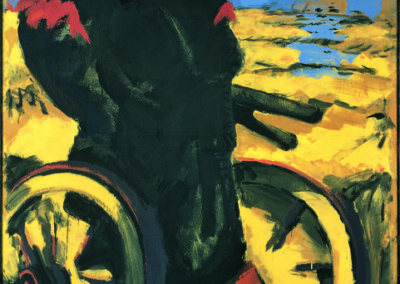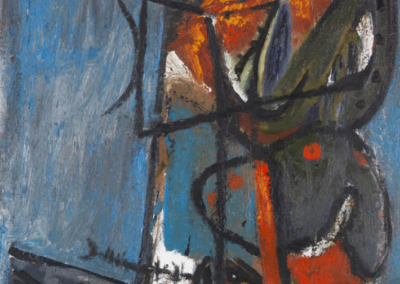Our next Artist You Need To Know is Markus Lüpertz. He is a painter, sculptor, and writer known just as much for his irreverent humour as for sculpture and paintings.
Lüpertz was part of an engaging post WWII generation of artists in Germany (perhaps the best known of this group are Gerhard Richter and Georg Baselitz): his work often employed – and mixed – themes of classical literature, biblical stories, historical narratives and mythology. A sometimes controversial figure as his artwork has not neglected to include less savoury aspects of German history (he has been known to include Nazi symbology, providing a more critical and challenging contextualization of German history), his work incorporates both abstraction and representation while also touching upon modern advertising. Lüpertz’ paintings have been described as bold and raw with an intensity of colour and form: his sculptures often seem deformed, misshapen or even grotesque.
“My concern isn’t to provoke people, my concern is to deliver quality, that’s all I can do. Sometimes it makes me feel ill, or unloved. I put all my passion and commitment into it, at the very least you should respect my work, even if you don’t like it. But people are too stupid for art, for great art. You can write that in bold letters: The people are too stupid for great painting.” (from here)
Markus Lüpertz was born in 1941 in Liberec, Bohemia (now the Czech Republic), but his family migrated to Rheydt, Germany, in 1948. Lüpertz studied at the Werkkunstschule Krefeld, but worked as a coal miner for a year before studying at Academie Düsseldorf. “His short presence at the Academy ended as a “huge fiasco”, and a “physical conflict that escalated a lot” led to his exmatriculation. “As an unloved, as an outcast, I have been expelled from this house,” Lüpertz remembered in retrospect, this “embarrassing defeat” of his student days.” (from here)
He also, during this period, spent time working in road construction and underground mining. Lüpertz also joined the French Foreign Legion but deserted before he could be sent to Algieria: his career as a painter truly began when he moved back to Berlin in 1962 and created his Dithyrambic Paintings (a term taken from philosopher Friedrich Nietzsche). Many of his works as a young artist cited pop culture, as in his paintings using imagery of Mickey Mouse or Donald Duck. He has described this as a response to the prevalence of modernist ‘pure’ abstraction at the time.
He opened the Galerie Grossgörschen 35 in Berlin in 1964 with his exhibition Dithyrambic Malerei. Two years later, he published Art That Gets in the Way, Dithyrambic Manifesto.
During the period of 1969 to 1977, Lüpertz focused almost exclusively on German motifs that referenced the second World War: these included recurring symbols of steel helmets, shovels, flags or monumental antlers in a number of his large paintings. These artworks were often “executed in earthy colors and thematized the unmanaged German national pathos, where unfortunate memories of the Third Reich era were evoked.” (from here)
Lüpertz moved to Florence, Italy, in 1970, and won the German Critic”s Association Prize in 1974, and in the same year he organized the 1st Biennale of Berlin. For approximately 15 years, beginning in 1985, he mined art historical sources, often producing works heavily influence by – and re interpreting – classical masters like Jean-Baptiste Camille Corot and Nicolas Poussin.
He is also an accomplished writer: he published a collection of poems in 1981 and has edited a journal since 2003. Lüpertz has also worked in theater productions, designing for the operas Vincent in 1982, Werther in 1983, and The Storm in 1991. He also created one of 12 cathedral windows for Machabaerchir in St. Andreas Cathedral in Cologne.
Lüpertz’s sculptures are expressive and dominating, usually heads and faces and other fragmented bodily forms: he’s also had a number of sculptural works installed in the public sphere. These include a figure of Apollo for a niche in the Alte Oper in Frankfurt (1989), a bridge sculpture titled The Ugly Scares the Beauty (1990) in Karlsruhe, The Fallen Warrior in the Berlin Kantstrasse, an ensemble of three sculptures for the park of Schloss Bensberg (2000), The Philosopher created for the foyer of the new Berlin Chancellery (2001), and a sculpture of Apollo, inaugurated in the Elisabethenplatz in Bamberg (2009).
In 2001 Lüpertz created the mural The Six Virtues for the foyer of the new Federal Chancellery in Berlin.
“My painting is pure reflex. Painting is like watering flowers: Forget it once and the flower dies.” (from here)
His work can be found in the collections of the Albertina, the Kunstmuseum Bonn, the Museum Ludwig, the Stedelijk Museum, and the Tate, among others. Lüpertz was also an influential educator and led the Kunstakademie Düsseldorf for over 20 years (beginning in 1986) and has won many awards and accolades (notably the Lovis Corinth Prize of the Artists Guild).
Unsurprising for someone who is a writer as well as an artist, Lüpertz has given several interviews about his ideas and artwork in which he’s very erudite. These can be read here and here. Many more of his works can be seen here.
Lüpertz lives and works in Berlin, Karlsruhe, Düsseldorf and Florence.
























